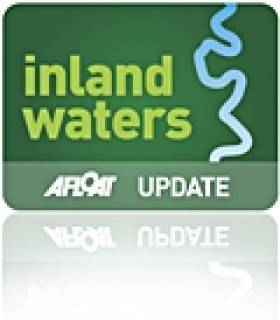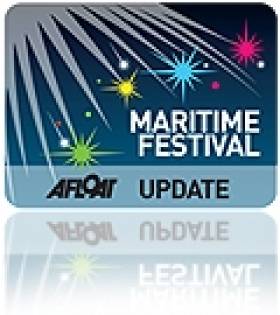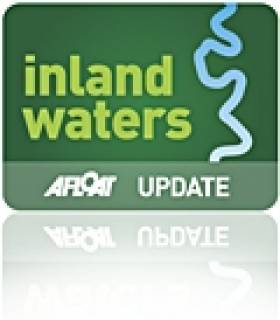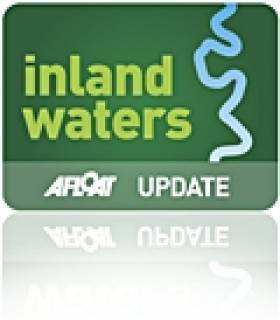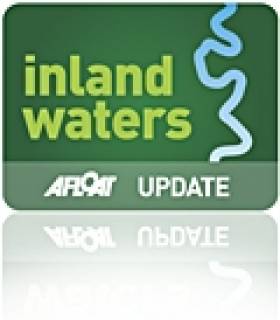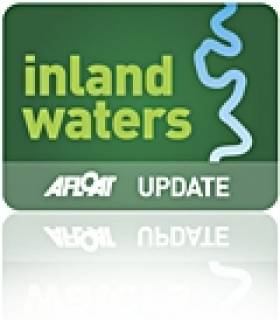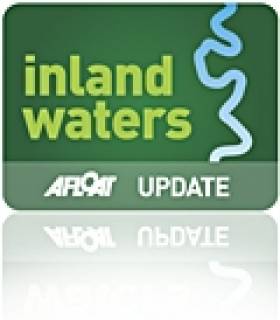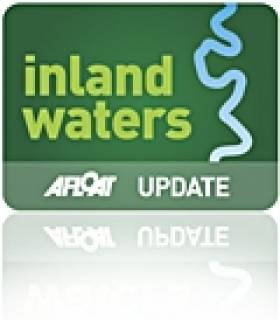Displaying items by tag: Inland
Waterways Ireland has advised that due to essential maintenance on one of the lock gates at Poolboy lock the entrance width to the lock is presently reduced to 4.2m. It is expected that the maintenance work will take approximately one week.
Masters are also reminded to check the air draft on approach to the Bord Na Mona bridge before transiting this stretch of the navigation as this may reduce quickly following localised heavy rainfall.
The air draft today is 2.85m. Please check with the Lock-keeper for the up to date air draft 00-353-(0)90909644938.
Canal Mooring Rules Change
#canals – Waterways Ireland has recognised that many boat owners wish to stay for a more extended period in a single location than the five days the annual Canal Mooring and Passage Permit (under the Canals Act, 1986 (Bye-laws), 1988) currently allows.
In response, Waterways Ireland intends to issue an Extended Mooring Licence granting a boat owner the right to leave their boat in one location for longer than 5 days. This permit will enable the holder to moor in a position allocated by Waterways Ireland on a soft bank area of navigation property for a period of up to 1 year. The Extended Mooring Licence will cost €152 per annum.
The application process for the Extended Mooring Licence will open in the autumn when all existing permit holders will be contacted.
All boat owners will still require an annual Canal Mooring and Passage Permit allowing the holder to cruise and pass through locks. Boat owners with a Canal Mooring and Passage Permit proposing to stay longer in one location than 5 days can then apply for the Extended Mooring Licence. The total fee to hold both the Permit and the Licence in 2012/2013 will be €278.
For boat owners with the Canal Mooring and Passage Permit who do not hold an Extended Mooring Licence the 5 day rule (in the one place or within 500m of that location) will still apply. Waterways Ireland will enforce this bye-law from autumn 2012.
Waterways Ireland will be contacting permit holders regularly between now and autumn 2012 to ensure they are kept up to date with the roll-out of the new permit. All queries about the enforcement of the current bye-laws or the Extended Mooring Licence should be directed to Shane Anderson, Assistant Inspector of Navigation: Tel no +353 (0)87 286 5726, Email [email protected] .
These changes are necessary steps to improve the management of the canals and waterway amenities for both the navigational and recreational user, so that investment in the new infrastructure and facilities which Waterways Ireland has undertaken is maximised for every user.
#DOCKLANDS – The Waterways Ireland Docklands Summer Festival 2012, bathed in gorgeous sunshine was a highly fun and exciting family event with over 100,000 people in attendance over the two days. The festival ran over Saturday 26th and Sunday 27th May and took place in the Docklands around the Grand Canal Basin.
Sponsored by Waterways Ireland and organised by members of Docklands Business Forum(DBF), the 2012 festival follows on from its inaugural success in 2011. Speaking at the launch, John Martin Chief Executive Waterways Ireland said "The Waterways Ireland Docklands Summer Festival highlighted the superb resources that the waterways provide within Dublin City Centre. All the organised events encouraged the public and those who work and live around the Docklands to participate in waterway activities and enjoy the fun and frolics off the water."
Last year over 50,000 people visited the festival. This year the organisers added even more events to ensure a bigger and better family day out. 100's of people watched the dragon races and thrilling wakeboarding demonstrations by the Irish Wakeboarding team and some even tried walking on water in a 'Waterroller!'. The Viking's from Dublinia invaded the Waterways Ireland Visitor Centre, running free children's crafts workshops, demonstrating Viking crafts, playing Viking games. All the workshops were fully subscribed. The Irish Navy has queues both days for visits to the L.E. Aoife on Sir John Rogersons Quay for the weekend.
The DBF in conjunction with Irish Village Markets provided face painting, balloon modelling and kiddies amusements. The performers from the World Street Performance Champions were also there and Irish Village Markets served up delicious foods from around the world. Visitors will also enjoyed food from a wide range of local suppliers including Il Valentino, Ely Restaurant and Herb Street.
As a special promotion local water sports experts, Surfdock, ran "come and try it" sessions. For those who fancy trying the exciting new sport of stand up paddling or have a go at kayaking the half-hour classes running over both days provided a great opportunity and were fully booked.
The local shops and businesses sold rubber ducks for a duck race in aid of cancer research charity Biobank Ireland and had a great turn out both days.
#LOUGHDERG – Plans to develop a comprehensive new signage programme for the Lough Derg area have been announced by the Lough Derg Marketing Strategy Group (LDMSG).
A signage audit has been carried out by consultants URS Ireland, and a presentation will be made on the initial findings of the consultants at two public meetings to be held this week in Portumna and Killaloe. The audit focuses on the need for and benefits of tourism signage, including orientation, interpretive and information boards in the Lough Derg area.
Lough Derg is home to one of Ireland's most comprehensive and best known network of Looped Walks, Driving Routes, Long-Distance Way Marked Ways, Linear Walks and Heritage Trails. The lake also is a popular destination for anglers and boating and watersports enthusiasts.
The preparation of the Lough Derg Signage Strategy comes less than three months after the LDMSG launched a smartphone application that uses GPS technology and Google Maps to guide tourists and outdoor enthusiasts around the trails and walks.
Mr. Joe MacGrath, LDMSG Chairperson and North Tipperary County Manager, explained: "The Lough Derg area, which incorporates parts of Galway, Clare and Tipperary, is regarded as one of the country's most valuable tourism assets. In the current economic climate, it is imperative that every effort is made to enhance visitor access to and awareness of all that the area has to offer. The development of a signage strategy will pave the way for a comprehensive marking of the area's principal tourist attractions and towns and villages."
"The LDMSG was established to bring a coherent marketing focus to the Lough Derg Catchment area and to establish the Lough Derg brand nationally and internationally. The development of a Signage Strategy is key to achieving this objective. It is hoped that it will help to link people to destinations within the wider Lough Derg area," Mr. MacGrath added.
Public meetings on the development of a Signage Strategy for the region will be held this Wednesday (May 30th) at Portumna Town and Community Hall in County Galway from 5.00pm to 6.30pm and at the Lakeside Hotel, Killaloe, County Clare, from 8.00pm to 9.30pm.
"All are welcome to attend either of this week's meetings and to have their say on the future approach to signage provision in the Lough Derg area. The meeting should be of interest to tourism and leisure businesses, accommodation providers, local community and heritage groups, walkers, cyclists, lake users, residents and anyone concerned with the improvement of signage in the Lough Derg Area," Mr. MacGrath concluded.
The LDMSG involves a broad range of representation from stakeholders, including local authorities from Galway, Clare and North Tipperary, the Mid-West Regional Authority, Shannon Development, Waterways Ireland, Fáilte Ireland, and business representatives from the Lough Derg area.
For further information on the Lough Derg Signage Strategy contact Deirdre Black at URS Ireland at 01 4155100
#INLAND – Waterways Ireland, together with food writer Georgina Campbell and Afloat's boating expert W.M. Nixon, recently launched the 2012 edition of A Taste of the Waterways. The Guide recommends places to eat and stay along the inland waterways managed by Waterways Ireland, and also includes maps and information on Things to See & Do along the way.
Establishments featured are independently assessed and recommendations are made on merit alone, with no fee charged for inclusion.
Georgina, who independently compiled the Taste guide, states "The 2012 Taste of the Waterways guide will introduce a lot of new visitors to a side of Ireland that is still unknown to many and what a wonderful surprise they have in store...Our beautiful rivers and canals lead the visitor right to the heart of Ireland and there is a special timeless quality to the way of life here. Community spirit is strong, visitors are made very welcome and, as well as a healthy choice of outdoor activities and sites to see, there's always plenty of music and craic to be found in friendly pubs along the way - also a generous sprinkling of good eating places, of course, and some lovely places to stay."
Featuring over 110 businesses along the 1000km of Ireland's inland waterways, the guide recommends selected establishments within a corridor along the Barrow Navigation, the Erne System, the Lower Bann, The Grand Canal, the Royal Canal, the Shannon-Erne Waterway and the Shannon Navigation.
Speaking about the guide Éanna Rowe, Head of Marketing & Communications with Waterways Ireland, highlighted 'This guide to selected food and hospitality premises along the waterways is not only for the boating public but also for those who come to walk, fish, canoe, cycle or sightsee along the beauty of the waterways and encourages them to stay, eat and spend more money in this environment. 'A Taste of the Waterways' provides a true experience of our inland waterways.'
The guide is free of charge and copies have been distributed to all registered boat owners and to tourist information centres nationwide.
In addition Waterways Ireland has developed a What's On Guide to give a listing of all the events taking place along the waterway corridor throughout the boating season and promote the use of the waterways by residents and tourists alike. Some of the events listed are also sponsored by Waterways Ireland and many feature a 'Come and Try It' session to encourage people of all ages to experience the waterways for themselves.
Renowned US based educator, boatbuilding expert Lance Lee will deliver a lecture as part of this weekend's Gandelow races event on the river Shannon in Limerick on Saturday.
The event is a celebration of historic Limerick City and Shannon estuary river ways. It also celebrates the building of five Gandelows, river boats which were once an integral part of the economic life of the City.
Founder of 'The Apprenticeshop' and 'Atlantic Challenge' Lee has been at the forefront of the movement to merge boats with experiential education for over 30 years. Drawing inspiration from educator Kurt Hahn and author Joseph Conrad, Lance's educational model uses boatbuilding and seamanship as a medium to teach self-reliance, competence and ultimately service to the community.
The public lecture starts at noon on Saturday in the City & Harris Suite, Strand Hotel, O'Callaghan Strand, Limerick.
#INLAND – The Mid West Regional Authority (MWRA) has been allocated €192,000 under an EU-funded programme to promote the environmental protection and economic development of the Mid West Region's principal waterways, including Lough Derg, the West Clare coastline, the River Shannon and the Shannon Estuary.
The Authority has been tasked with developing a regional policy tool aimed at ensuring the future planning and development of rivers and waters in counties Limerick, Clare and Tipperary are compliant with the Water Framework Directive (WFD). The objectives of the EU Directive are to protect all high status waters, prevent further deterioration of all waters and to restore degraded surface and ground waters to good status by 2015.
Under the terms of the EU-funded 'Territories of Rivers Action Plans' (TRAP) project, the MWRA also is working with authorities in 7 other European countries in relation to the exchange of information on best practices in landscape protection, management and planning, as outlined under the European Landscape Convention (ELC).
Commenting on the project, Linda Newport, EU Projects Officer, MWRA said: "The overall objective of the project is to facilitate the exchange of best practices between project partners' regions in an effort to promote environmental protection while also ensuring proper economic and social development. The end result should be an action plan for each region."
There are a number of public agencies involved in the Management of river territories in the Mid-West region, including Limerick City and County Councils, Clare County Council, North Tipperary County Council, the Environmental Protection Agency (EPA), Waterways Ireland, the inland fisheries, the Shannon Regional Fisheries Board, the ESB, the Office of Public Works and the Shannon-Foynes Port Company.
"The MWRA will work with all of these partners during the project which is co-funded by the ERDF Interreg IVC programme," explained Ms. Newport.
Other partners in this project include Kainuun Etu Ltd (Finland); Association of River Trusts (United Kingdom); Zemgale Planning Region (Latvia); Regional Development Agency of Western Macedonia SA (Greece), South-West Regional Authority and Shannon Development (Ireland); Waterboard Noorderzijlvest (the Netherlands); National Institute of Research Development for Mechatronics (Romania); and Soca Valley Development Centre (Slovenia).
"The benefit of the TRAP project for the Region is that the MWRA can benefit from exchanges with other partner regions, each of whom has particular expertise in one or more areas such as governance, monitoring, aquatic environment or river tourism. The MWRA, for example, will share its best practises in the area of governance, given its extensive experience of Regional Planning Guidelines and the important role that they can play in the sustainable development of an area. Likewise, the MWRA will import knowledge and expertise from other more experienced partners," Ms. Newport concluded.
The Mid-West Region is dominated by water with its distinctive Atlantic Coastline to the West, the River Shannon, Shannon Estuary and Lough Derg. The MWRA is currently coordinator of the Lough Derg Marketing Strategy Group, which is responsible for promoting and developing activities around the lake, in cooperation with the Local Authorities and representatives from local businesses and trades. It is also a member of the Shannon River Basin District Management Project.
Gandelow Races Return to Limerick City
#GANDELOW – Traditional Gandelow rowing races will be held on the river Shannon in Limerick City on Saturday, May 19th 2012. The day will begin with a reception and presentation of boats, followed by public talks and racing.
The event is a celebration of historic Limerick City and Shannon estuary river ways. It also celebrates the building of five Gandelows, river boats which were once an integral part of the economic life of the City. Though naval in style, Gandelows continue to contribute richly to the architectural mix that makes up the built City.
It is also a celebration of the work of the ILEN Wooden Boat Building School who, in collaboration with river folk and community groups, have come together to build five boats and stage a cultural and educational river event.
The programme is as follows:
Morning Programme, Venue Strand Hotel:
10.30am – Reception and presentation of Limerick city's new fleet of Gandelows
11.00am – Public Lectures in the City & Harris Suite, Strand Hotel
11.15am – Lecture by Anthony Keane OSB – 'They sailed to the sea in ships',
Anthony Keane is a Benedictine Monk & Forester. He has been a monk of Glenstal Abbey for more than thirty years and is also a founding director of the AK Ilen Company as well as a Gandelow Races organiser.
12.00pm – Lecture by Lance Lee USA – Wooden Boatbuilding & Community Education
Lance Lee, founder of several incarnations of The Apprenticeshop Maine USA, of Atlantic Challenge International, and of the Tremolino! Project, has worked on numerous boatbuilding projects with hundreds of students and boatbuilders – all over the world.
His journey in wooden boatbuilding education began in 1968 and when many men would be winding down, Lance Lee continues to embrace new challenges. One of his recent projects, was working with boatbuilder Brady Gow to build a smaller version ofTremolino, the lateen-rigged balancelle (a Mediterranean workboat) used by Joseph Conrad to run guns for the royalist cause between Marseilles and Catalonia in the late 1800s. This should prove to be a most stimulating and inspiring lecture.
1.00pm – Lunch break
Afternoon Programme, Racing between Sarsfiled Bridge and Shannon Bridge
2.30pm – Launch of boats
3.00pm – First of three races commences
4.30pm – Prize giving and closing address
For more information please call Mobile 086 2640479 or email: [email protected]
Rare White Tailed Eagles Nesting on Lough Derg Island
#INLAND – A pair of very rare white-tailed eagles have built a nest and are breeding on Bushy Island, Lough Derg on the Shannon navigation.
Bushy Island is a low lying island in the centre of Mountshannon Bay approx. 3 acres and, despite its name, is quite sparsely wooded. It is popular with boaters as it is a perfect place to picnic and is accessible by pier.
Boaters have been asked by Waterways Ireland that in order to protect the eagles that skippers observe a voluntary exclusion zone by not encroaching within 250m of the island.
Videos of White Tailed Eagles here
Discover Killaloe and Ballina takes place on Sunday 29th April from 1-6pm as locals and visitors alike are encouraged to come along and enjoy an afternoon of free activities with fun for all the family.
As previously reported on Afloat.ie the events include free 'Come and Try It' sessions for kayaking, sailing, powerboating, angling and arts; historic town walking tours, boats trips, tours of the Cathedral, community garden and self-catering accommodation. The market will be selling their produce Between the Waters and artisans their crafts in the Cathedral. Many hospitality and retail outlets will also have special promotions running. The Discover Killaloe & Ballina brochure is available throughout the town and online at discover.ireland.ie/lakelands. Events are being co-ordinated locally via a steering group formed from representatives of local businesses and chaired by local business owner Doug Hyde.
Organised by Waterways Ireland, Fáilte Ireland, Shannon Development, North Tipp and Clare County Councils, the open day will provide an opportunity to raise awareness of the tourism assets of the Killaloe & Ballina region.
The Discover Killaloe & Ballina initiative is part of a broader campaign to develop and promote Ireland's Lakelands and Inland Waterways which aims to significantly boost visitor numbers to the Lakeland regions over the next three years.
Minister Alan Kelly TD at the launch of the Discover stated 'I'm delighted to launch this 'Discover Ballina/Killaloe' event and to see it come to fruition. The Ballina-Killaloe area is a hidden secret and I'm delighted Fáilte Ireland working with Waterways Ireland have chosen to recognise its great tourism potential and I only see that growing into the future. I want to recognise the efforts of all the local tourism and hospitality operators as well as the broader community of Ballina/Killaloe for their support for this and other initiatives that will go a long way to promoting the area and supporting local job creation'.
According to Éanna Rowe, Director of Marketing and Communications at Waterways Ireland– "Discover Killaloe & Ballina will highlight to locals and tourists the incredible diversity and quality of attractions, activities and entertainments in this area. It will enhance the capacity of everyone to promote Killaloe & Ballina nationally and internationally and is expected to have an impact on tourist numbers and the local economy."
Fiona Monaghan, Fáilte Ireland, said – "This is a great opportunity for the communities of Killaloe & Ballina to showcase the variety of tourism & hospitality experiences in their community, which we hope will encourage everyone to act as ambassadors for Killaloe/Ballina and Lough Derg for both domestic & international visitors. They may even consider inviting friends to join them for the weekend to sample the delights of Killaloe & Ballina and its environs. This celebration is a great example of community spirit and collaboration and I would like to commend the communities for their support & commitment. Ireland's Lakelands and Inland Waterways can provide unique experiences for everyone. The natural environment provides excellent opportunities to participate in a huge range of sightseeing, cultural and outdoor activities."
This year a Discover Killaloe & Ballina Colouring Competition is running in the lead up to the event inviting all local school children to discover their very own Killaloe & Ballina. The closing date for entries is 19th April. All entries will be on display in St Anne community College in Killaloe on 29th April from 1-5 pm.
Doug Hyde Chairman of Discover Killaloe & Ballina welcomed the event Also speaking at the event, said "this is a great initiative for Killaloe & Ballina and Counties Clare and North Tipperary as it gives a wonderful opportunity for people to realize the wealth of activity that is on offer for visitors and residents. We have a great product in and around Killaloe & Ballina and we need to show others what a brilliant place it is to stay in."






























